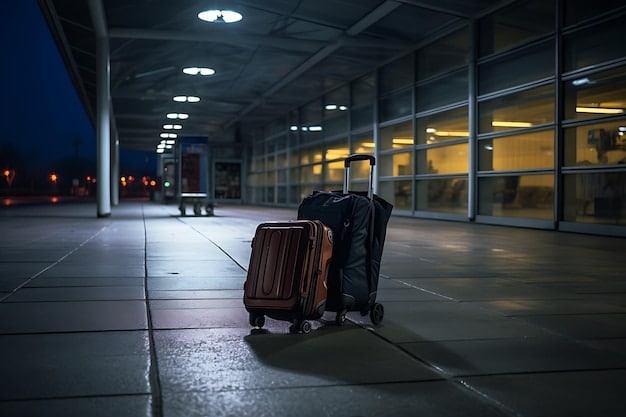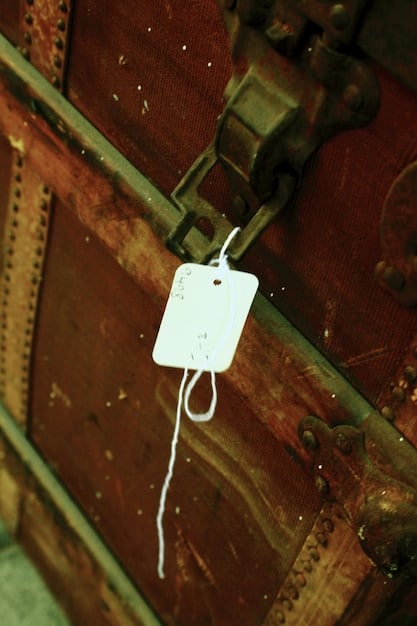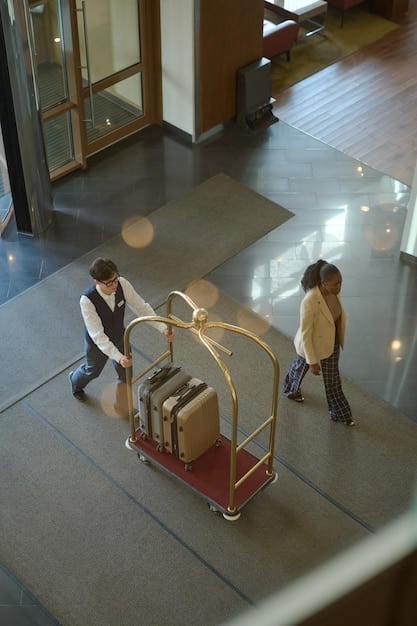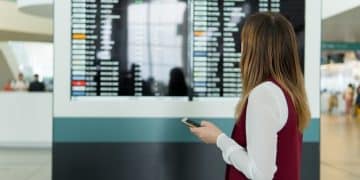US Airlines Report 15% Increase in Lost Luggage: How to Protect Your Belongings

Recent data indicates a concerning 15% surge in lost luggage incidents across US airlines, prompting a critical need for travelers to adopt proactive measures and informed strategies to safeguard their belongings and ensure peace of mind during air travel.
Recent reports reveal a significant and concerning trend: US airlines have experienced a 15% increase in lost luggage. This surge directly impacts countless travelers, transforming anticipated journeys into stressful ordeals. Understanding why this is happening and, more importantly, how to navigate this challenge is crucial for anyone planning air travel.
Understanding the Rise in Lost Luggage Incidents
The recent 15% increase in lost luggage by US airlines is not merely a statistical anomaly; it reflects a confluence of factors within the dynamic and often tumultuous aviation industry. To truly grasp the implications for travelers, it’s essential to dissect these underlying causes, moving beyond superficial explanations to a deeper understanding of the systemic pressures at play.
One primary contributor has been the rapid resurgence in passenger numbers post-pandemic. Airlines, eager to capitalize on renewed demand, have quickly ramped up flight schedules. However, this acceleration has frequently outpaced the pace of workforce re-stabilization and infrastructure recalibration. Many airlines faced significant layoffs and early retirements during the pandemic, leading to a depleted talent pool within baggage handling operations, logistics, and ground crew roles. The onboarding and training of new staff, while necessary, invariably introduce inefficiencies and a learning curve, contributing to errors in the intricate process of baggage transfer.
Impact of Staffing Shortages on Baggage Handling
- Reduced Efficiency: Fewer trained personnel mean longer processing times and increased likelihood of misdirection.
- Increased Workload: Existing staff often handle higher volumes, leading to fatigue and oversight.
- Training Gaps: New hires may lack the experience to quickly identify and rectify unusual baggage routing.
Beyond staffing, the complexity of modern air travel also plays a significant role. With more connecting flights and tight layovers, particularly at busy hub airports, the margin for error in transferring luggage becomes infinitesimally small. A slight delay on an incoming flight can mean a suitcase misses its connection, even if the passenger makes it. This is compounded by the sheer volume of bags processed daily—millions globally—making even a small percentage of errors translate into thousands of misplaced items.
Furthermore, technological limitations, though continuously improving, still pose challenges. While bag tracking systems are more advanced than ever, they are not foolproof. Barcode misreads, system glitches, or human errors in scanning can lead to a bag being routed incorrectly, especially when multiple airlines are involved in a single itinerary. The integration between different airline systems, particularly for codeshare flights, is not always seamless, creating more opportunities for bags to fall through the cracks.
Seasonal Peaks and Operational Strains
Certain periods, such as peak holiday seasons or summer travel, exacerbate these issues. The sheer volume of passengers and bags during these times places immense strain on an already stretched system. Adverse weather conditions, which can cause cascading flight delays and cancellations, further disrupt baggage flows, as handlers struggle to re-route bags amidst chaotic operational changes.
The airlines themselves are under immense pressure to maintain profitability and on-time performance, sometimes leading to decisions that inadvertently impact baggage handling. Quick turnarounds, while efficient for aircraft utilization, leave minimal time for meticulous bag loading and unloading, increasing the rush and potential for errors. This intricate web of factors collectively contributes to the disheartening statistics of rising lost luggage, transforming what seems like a simple process into a complex logistical challenge.
Understanding these contributing factors is the first step in empowering travelers. It shifts the perspective from mere frustration to a strategic awareness, allowing for better preparation and mitigation of risks. While airlines work to address these systemic issues, travelers can equip themselves with knowledge and practical steps to minimize their personal exposure to the rising tide of lost luggage.
Immediate Steps If Your Luggage Goes Missing
The dreadful moment arrives: you’re at the baggage carousel, the last bag spins by, and yours isn’t there. Panic can quickly set in, but knowing the immediate, structured steps to take can significantly improve your chances of recovery and mitigate the stress of the situation. Acting promptly and systematically is key, as missteps or delays can complicate the process of retrieving your belongings.
Your first action should be to remain calm and approach the airline’s baggage service desk. This is crucial; do not leave the airport without formally reporting the missing bag. The more immediate your report, the higher the likelihood of the bag being located quickly, especially if it was simply misrouted within the same airport. Be prepared to provide detailed information about your flight and the missing luggage.
Information to Provide When Reporting Lost Luggage
- Flight Details: Airline name, flight number(s), date, and origin/destination airports.
- Bag Description: Color, brand, size, distinctive features (e.g., stickers, tags), material.
- Contents List: A general idea of what’s inside (e.g., “men’s clothing, toiletries, books”)—avoid oversharing or listing valuables yet.
- Contact Information: Your name, phone number, email, and temporary address if you’re traveling.
Once you’ve provided this information, the airline will typically create a Property Irregularity Report (PIR) or a similar tracking reference. This document is your official proof of reporting and contains a unique number that you will use to track your bag’s status online or through phone calls. It’s imperative that you keep this PIR number safe, photographing it or writing it down immediately. Without it, tracking your claim becomes incredibly difficult.
Inquire about interim relief or compensation. Depending on the airline and your location (e.g., DOT regulations in the US, Montreal Convention internationally), you might be entitled to immediate funds to purchase essential items like toiletries, a change of clothes, or medication. Some airlines offer a daily stipend for delayed bags. Document any expenses you incur due to the lost luggage, keeping all receipts, as these will be vital for any future claims.
Before leaving the desk, clarify the airline’s communication process. Will they text, email, or call with updates? What’s the best way for you to check the status? Understanding their protocol will save you needless anxiety and repeated calls. Also, ask about the average timeframe for locating bags and what happens if your bag isn’t found within that period. This sets realistic expectations about the recovery process.
While the airline bears the primary responsibility, a proactive approach from the traveler’s side can significantly aid the process. This includes taking photos of your checked baggage before handing it over, especially if it has unique identifiers. Such visual proof can be invaluable in distinguishing your bag from others if it’s located in a pile of unclaimed luggage.

Finally, understand that patience is a virtue, but persistence is key. While airlines strive to reunite passengers with their belongings, the process can be lengthy. Regularly checking the status using your PIR number and following up with the airline (through their official channels, not social media for initial reports) demonstrates your commitment and can sometimes expedite the search. Being informed, prepared, and assertive in your actions after a bag goes missing can transform a potentially devastating experience into a manageable situation.
Proactive Strategies to Prevent Lost Luggage
While the recent surge in lost luggage statistics is concerning, travelers are not entirely powerless. Adopting a proactive mindset and implementing strategic measures before even setting foot in the airport can significantly reduce the risk of your bags joining the ranks of the missing. Prevention, in this scenario, is far more effective and less stressful than recovery.
One of the most effective strategies is to strategically pack your carry-on bag. The golden rule is to always carry essential items, valuables, and anything irreplaceable in your cabin luggage. This includes medications, important documents (passport, visas, IDs), electronics, jewelry, a change of clothes, and any cherished sentimental items. If your checked bag does go astray, you’ll still have your critical necessities, minimizing immediate disruption and stress.
Maximizing Your Carry-On for Essentials
- Medications: Always keep prescription drugs, especially those needed daily, in your carry-on.
- Valuables: Laptops, cameras, expensive jewelry, and irreplaceable sentimental items belong with you.
- Documents: Passport, ID, boarding passes, travel insurance details are paramount.
- Basic Kit: A toothbrush, a small outfit, and essential toiletries can tide you over for 24-48 hours.
Another crucial preventative measure involves bag identification. Make your checked luggage stand out. While standard luggage tags are helpful, they can detach or be misread. Consider using bright, distinctive luggage tags, colorful straps, or even unique stickers to make your bag instantly recognizable amidst a sea of similar-looking suitcases. Inside your bag, place a secondary form of identification, such as a business card or a small note with your contact information, directly on top of your clothing. This serves as a backup if the external tag is lost.
For tech-savvy travelers, consider investing in a luggage tracker. Devices like Apple AirTags or Tile trackers can be slipped into your checked bag and allow you to monitor its location via a smartphone app. While not foolproof—they rely on Bluetooth signals from nearby devices—they can provide a general idea of your bag’s last known location, which can be invaluable information for the airline’s baggage services and for your peace of mind.
Beyond physical identification, be mindful of direct flights versus connecting flights. Whenever possible, opt for direct flights if you are checking luggage. Each connection point increases the risk of your bag being misrouted due to tight transfer times or handling errors between different ground crews or airlines. If a connecting flight is unavoidable, ensure there is ample layover time for your bags to be transferred, ideally at least two hours.
Finally, meticulous tagging and removal of old tags are essential. Always remove any old airline tags or barcodes from previous flights from your luggage. These can confuse automated baggage handling systems and lead to misdirection. Ensure the new tag provided at check-in is securely attached and that the destination on the tag matches your final destination. A quick double-check at the counter can prevent a significant headache later.
By integrating these proactive strategies into your pre-travel routine, you can significantly mitigate the risk of experiencing the frustration of lost luggage. These steps empower you to take control, turning passive hope into active prevention, ensuring your journey is as smooth and stress-free as possible, regardless of the broader industry trends.
Leveraging Technology for Bag Tracking and Recovery
In an era defined by digital connectivity, technology offers increasingly sophisticated solutions for managing the perennial problem of lost luggage. While airlines are continuously upgrading their systems, travelers now have access to a suite of personal tech tools that can provide unprecedented visibility into their bags’ whereabouts, transforming the recovery process from anxious waiting to informed tracking. Embracing these technological aids is a crucial part of modern travel preparedness.
The most widely adopted and effective personal tracking devices are Bluetooth (like Apple AirTags, Tile, or Samsung SmartTags) and GPS trackers. These small, relatively inexpensive devices can be slipped into your checked bag. Bluetooth trackers utilize a network of nearby compatible devices (e.g., iPhones for AirTags) to relay their location to you. While their range is limited to the proximity of these networks, they are incredibly effective in densely populated areas like airports and cities, providing real-time proximity alerts and last-known locations.
Benefits of Personal Bag Trackers
- Real-Time Location Data: See exactly where your bag is (or last was) on a map.
- Peace of Mind: Reduce anxiety knowing you have an independent way to track your belongings.
- Faster Recovery: Provide airlines with specific location information that can expedite the search process.
- Theft Deterrent: In some cases, knowing a bag’s location can aid in recovery if it’s stolen.
GPS trackers offer broader coverage, often utilizing cellular networks, but typically come with a higher price tag and may require a subscription. They are ideal for situations where your bag might be in a less populated area or if you need constant, widespread tracking capabilities. The choice between Bluetooth and GPS depends on your budget, travel frequency, and desired level of precision.
Beyond personal trackers, many airlines and airports are integrating advanced baggage tracking systems. While not always directly accessible to the passenger in real-time, these systems often use RFID (Radio-Frequency Identification) technology or enhanced barcode scanners to log a bag’s journey at various touchpoints. Some leading airlines now offer their own apps that allow passengers to track their checked bags from check-in to carousel delivery, providing updates similar to how package delivery services work. It’s always advisable to download your airline’s app before travel to check if this feature is available.
When your bag does go missing, the data from your personal tracker can be invaluable. Instead of simply reporting a missing bag, you can approach the airline desk armed with specific information like, “My AirTag shows my bag is still at [connecting airport] in Terminal X.” This can significantly narrow down the search area for baggage handlers, allowing them to pinpoint the bag’s location far more rapidly than traditional manual searches.
However, it’s important to set realistic expectations. While technology can show you where your bag is, it doesn’t give you direct access to it. You still need the airline to retrieve and deliver it to you. Nevertheless, the ability to provide specific location data empowers the traveler and transforms the dynamics of the bag recovery process, shifting it from a reactive search to a more precise, data-driven effort. In an environment where airline baggage systems are under strain, these personal technological investments offer a significant layer of security and control for the modern traveler.
Travel Insurance: Your Financial Safety Net
While proactive measures and technological aids can significantly reduce the risk of lost luggage, sometimes, despite best efforts, bags still go missing. This is where travel insurance emerges as a critical financial safety net, offering protection and compensation for the unforeseen tribulations associated with lost, delayed, or damaged baggage. Understanding the nuances of your travel insurance policy is as important as any physical preparation for your journey.
Travel insurance policies typically offer several tiers of coverage related to baggage. The most common are coverage for delayed baggage, lost baggage, and damaged baggage. Each comes with its own set of conditions, deductibles, and compensation limits. It’s vital to read the fine print to understand what is covered, to what extent, and what documentation is required to file a claim.
Key Aspects of Travel Insurance Baggage Coverage
- Delayed Baggage: Provides funds for essential purchases (toiletries, clothing) if your bag is delayed beyond a specific period (e.g., 6-12 hours).
- Lost Baggage: Offers compensation up to a certain limit for the depreciated value of your belongings if your bag is declared permanently lost by the airline.
- Damaged Baggage: Covers the cost of repair or replacement if your luggage is physically damaged during transit.
When considering a policy, pay close attention to the coverage limits. These limits can vary widely, from a few hundred dollars to several thousand, depending on the premium paid. If you plan to travel with expensive items—though it’s always advisable to carry them in your hand luggage—ensure your policy’s limits are sufficient to cover their potential loss. Some policies may also have specific sub-limits for high-value items like electronics, jewelry, or sporting equipment, often requiring them to be declared or itemized.
Filing a claim for lost or delayed baggage requires meticulous documentation. This typically includes the Property Irregularity Report (PIR) from the airline, proof of purchase for the lost items (receipts, credit card statements), and receipts for any essential items you had to buy due to a delay. Without proper documentation, your claim might be denied or significantly reduced. It’s a good practice to photograph your luggage and its contents before you travel, providing visual evidence of what was packed.
It’s also important to understand the concept of “depreciated value.” Most insurance policies do not reimburse you for the full retail cost of items, particularly clothing or older electronics. Instead, they compensate based on the item’s value at the time of loss, accounting for wear and tear. This can sometimes lead to a lower payout than anticipated, reinforcing the importance of keeping truly irreplaceable or extremely valuable items out of checked luggage.
Before purchasing a standalone travel insurance policy, check if you already have coverage through your credit card or homeowner’s/renter’s insurance. Many premium credit cards offer complimentary travel insurance benefits, including baggage protection, when you pay for your flight with that card. Your homeowner’s or renter’s insurance might also extend coverage to your belongings while traveling, although often with higher deductibles. This layered approach to coverage can provide comprehensive protection, but it requires careful review to avoid overlaps or gaps.
While no one hopes to claim on their travel insurance, it provides immense peace of mind in an increasingly unpredictable travel landscape. Investing in a robust policy, understanding its terms, and diligently documenting your belongings can transform the frustration of lost luggage into a more manageable financial inconvenience, allowing you to focus on enjoying your trip despite setbacks.
Airline Responsibility and Passenger Rights
When luggage goes missing, it’s not just an inconvenience; it can be a significant financial and emotional burden. Understanding your rights as a passenger and the responsibilities of US airlines is paramount in such situations, empowering you to navigate the claims process effectively and ensure you receive the compensation or assistance you’re entitled to under federal regulations and international agreements. Knowledge is your strongest ally when dealing with airline bureaucracy.
In the United States, the Department of Transportation (DOT) regulates airlines and outlines passenger rights regarding lost, damaged, or delayed baggage on domestic flights. For international flights, the Montreal Convention (or its predecessor, the Warsaw Convention) governs airline liability. These frameworks set limits on an airline’s maximum liability, which passengers should be aware of, as these caps can often fall short of covering the actual value of expensive belongings.
Key Passenger Rights and Airline Obligations
- DOT Domestic Liability: For flights within the US, airlines are liable for up to $3,800 per passenger for lost, damaged, or delayed bags.
- Montreal Convention (International): Liability for international flights is approximately 1,288 Special Drawing Rights (SDRs) per passenger (about $1,750 USD, though subject to currency fluctuations).
- Reporting Timelines: Passengers must report lost/damaged bags to the airline within specific timeframes (e.g., 24 hours for damaged bags, before leaving the airport for lost bags).
- Reasonable Reimbursement: Airlines are required to provide reasonable reimbursement for essential items if luggage is delayed.
It’s crucial to understand that these liability limits are maximums, not guarantees. The airline will typically reimburse you for the depreciated value of your items, not their replacement cost, and may require proof of purchase. This is why keeping receipts for high-value items or having separate travel insurance is often advisable, especially if your luggage contains items exceeding these liability caps.
The process of reporting a problem with your luggage is formal. You must file a Property Irregularity Report (PIR) at the airport baggage service desk before leaving, or at least within specific periods (e.g., usually within a few hours for lost bags, or 7 days for damaged bags for international flights, though best immediately). This report initiates the airline’s official process and is necessary for any future claims, whether with the airline or your travel insurance provider.
If your bag is delayed, airlines generally have rules for providing funds for essential purchases. This can vary by airline, but it’s reasonable to expect some form of immediate compensation if your bag doesn’t arrive within 6-12 hours of your flight. Keep all receipts for these necessary purchases, as they will be required for reimbursement. Airlines have a certain period (e.g., 5-7 days for domestic flights, 21 days for international) before a delayed bag is formally declared “lost.”
Should the airline’s initial response or compensation be unsatisfactory, passengers have avenues for escalation. You can formally write to the airline’s customer relations department, referencing your PIR number. If resolution isn’t achieved, you can file a complaint with the Department of Transportation (DOT) for domestic flights or seek legal advice for international claims under the Montreal Convention. The DOT carefully monitors airline performance and customer complaints, which can sometimes spur action.
While airlines ultimately strive to deliver your luggage safely, the sheer volume of bags and the complexities of air travel mean mishaps occur. By being aware of your rights, acting promptly, meticulously documenting your case, and understanding the scope of airline liability, you position yourself to navigate the often-frustrating process of lost luggage recovery with confidence and ensure you receive the fair treatment you are entitled to.
Future Outlook: Innovations in Baggage Handling
The recent spike in lost luggage, while a setback, is also a catalyst for accelerated innovation within the aviation industry’s baggage handling ecosystem. Airlines, airports, and technology providers are investing heavily in solutions designed to prevent misplacements, expedite recovery, and ultimately restore passenger confidence. Looking ahead, the future of baggage handling promises to be far more integrated, transparent, and resilient.
One of the most significant advancements is the widespread adoption of RFID (Radio-Frequency Identification) technology for baggage tags. Unlike traditional barcodes, which require a direct line of sight to be scanned, RFID tags can be read automatically from a distance, even if partially obscured or in a stack of bags. This greatly reduces manual scanning errors and speeds up the sorting process. Many industry leaders, including IATA, are advocating for universal RFID implementation, which could drastically cut down misdirected bags.
Emerging Technologies in Baggage Handling
- Robotics and Automation: Automated systems for loading, unloading, and transferring bags, reducing human error.
- Biometric Bag Drops: Self-service kiosks that use facial recognition to link passengers to their bags, streamlining check-in.
- Advanced Predictive Analytics: AI-powered systems that analyze flight schedules, weather, and passenger data to predict and prevent potential bag misconnections.
- Enhanced Digital Tracking: More robust airline apps offering granular, real-time updates on bag location for passengers, powered by integrated airport systems.
Beyond tracking, airports are increasingly implementing highly automated baggage handling systems. These sophisticated networks of conveyors, sorters, and robotic arms can process thousands of bags per hour with remarkable precision. The goal is to minimize human intervention, which is often cited as a common source of errors. While the initial investment is substantial, the long-term benefits in efficiency, speed, and accuracy are compelling for major hubs.
Another area of innovation is predictive analytics and artificial intelligence (AI). Airlines and airports are beginning to use AI to analyze vast datasets related to flight schedules, passenger connections, weather patterns, and historical baggage performance. This allows them to identify potential bottlenecks or at-risk bags before issues arise, enabling proactive intervention, such as re-routing a bag earlier or assigning additional ground staff to a particular transfer point. This shift from reactive problem-solving to proactive prevention is a game-changer.
For passengers, the future likely holds more comprehensive and transparent tracking options. Imagine an airline app that not only tells you your bag is “on the way” but shows its precise location within the airport, or that it just cleared customs, analogous to tracking a package from a major e-commerce retailer. This level of transparency, powered by integrated data systems across airlines and airports, will empower travelers and reduce anxiety significantly.
The commitment to innovation extends to the entire travel ecosystem. Collaborations between airlines, airports, ground handlers, and technology providers are becoming more common, recognizing that a unified approach is necessary to tackle complex logistical challenges. While the path to a completely seamless baggage experience is ongoing, the current wave of technological advancements and strategic investments suggests a future where lost luggage becomes a rare exception rather than a frustratingly frequent occurrence, restoring much-needed confidence to the traveling public.
| Key Point | Brief Description |
|---|---|
| ✈️ Increased Incidents | US airlines report a 15% surge in lost luggage, impacting countless travelers due to various factors. |
| 👟 Proactive Prevention | Pack essentials in carry-on, make bags stand out, use old tag removal, and consider direct flights. |
| 📱 Tech for Tracking | Utilize personal bag trackers (AirTags, Tiles) and airline apps for real-time location updates. |
| 🛡️ Insurance & Rights | Travel insurance provides financial safety, while understanding DOT and Montreal Convention limits protects passenger rights. |
Frequently Asked Questions about Lost Luggage
▼
If your luggage is lost, immediately go to the airline’s baggage service desk before leaving the airport. File a Property Irregularity Report (PIR) and obtain a tracking number. Provide detailed descriptions of your bag and its contents, and ask about interim compensation for essential items. Keep all documentation for future claims.
▼
To boost recovery chances, ensure your bag has unique identifiers like colorful tags or straps. Place a secondary ID with contact information inside. Consider using a personal GPS or Bluetooth tracker (like an AirTag) in your bag, which can provide real-time location data to assist airline staff in their search.
▼
Yes, most travel insurance policies cover lost luggage, offering compensation for delayed, lost, or damaged bags. Coverage limits vary, often based on depreciated value. You’ll generally need to file an airline PIR and provide receipts for lost items or essential purchases made due to delays to initiate a claim.
▼
US airlines are typically liable for up to $3,800 per passenger for lost or damaged bags on domestic flights, as per DOT regulations. For international flights, the Montreal Convention applies, with different liability limits. Airlines are also expected to offer reasonable reimbursement for essential items if your bag is delayed beyond a defined period.
▼
Absolutely. The aviation industry is adopting new technologies like RFID baggage tags for better tracking, advanced automated handling systems to reduce human error, and AI-powered predictive analytics to anticipate and prevent misconnections. These innovations aim to make baggage handling more efficient, transparent, and significantly reduce future loss rates.
Conclusion
The recent 15% increase in lost luggage incidents on US airlines underscores a critical challenge for the travel industry and a source of considerable frustration for passengers. While external factors like staffing shortages and increased flight complexity contribute to this regrettable trend, travelers are not without recourse. By adopting proactive measures such as discerning packing, distinct bag identification, and leveraging personal tracking technologies, individuals can significantly mitigate their risk. Furthermore, understanding passenger rights and the role of travel insurance provides a vital safety net, transforming potential despair into manageable inconvenience. As the industry continues to evolve with promising innovations in baggage handling, remaining informed and prepared empowers travelers to navigate the skies with greater confidence, ensuring their belongings largely remain as committed to their journey as they are.






